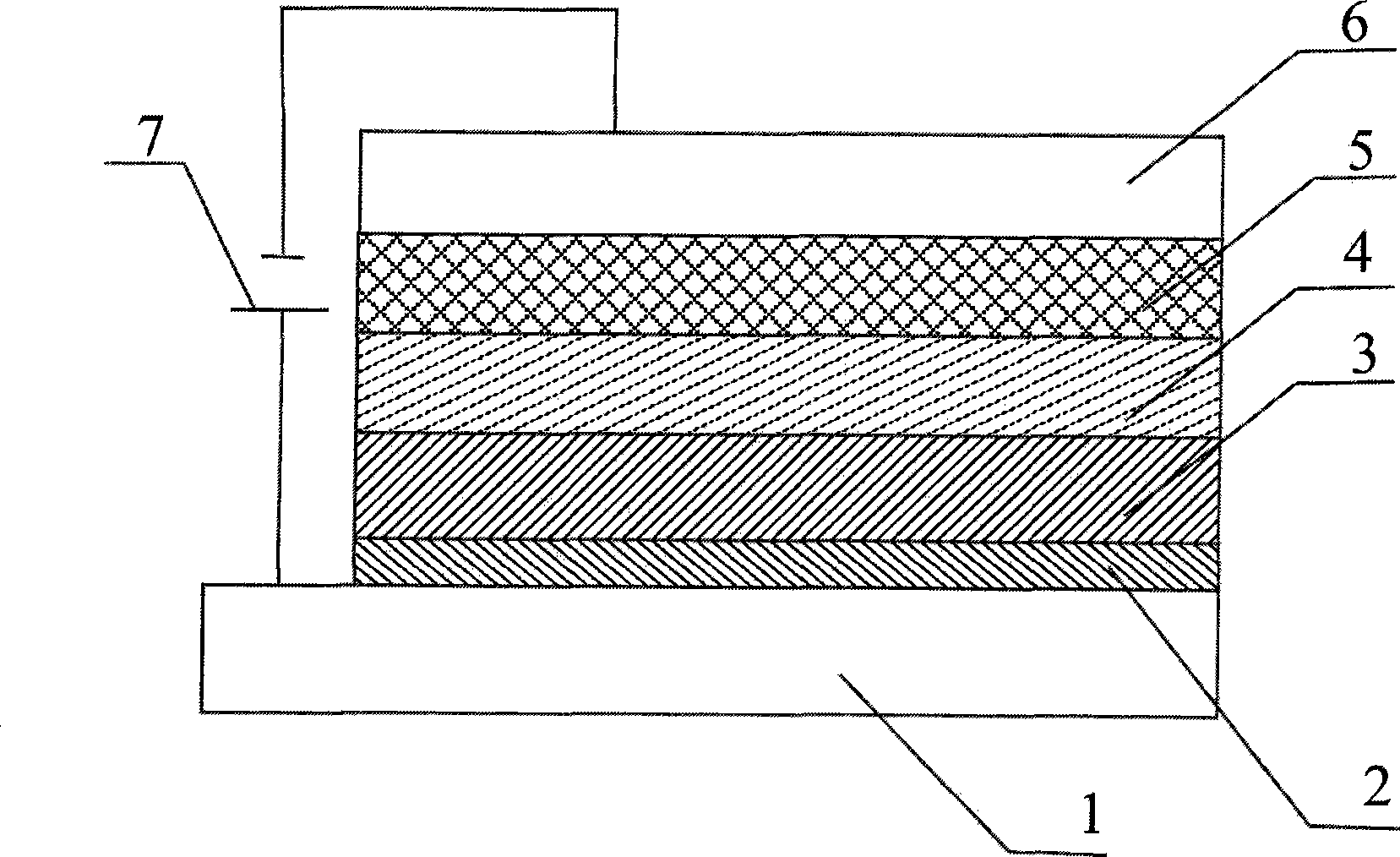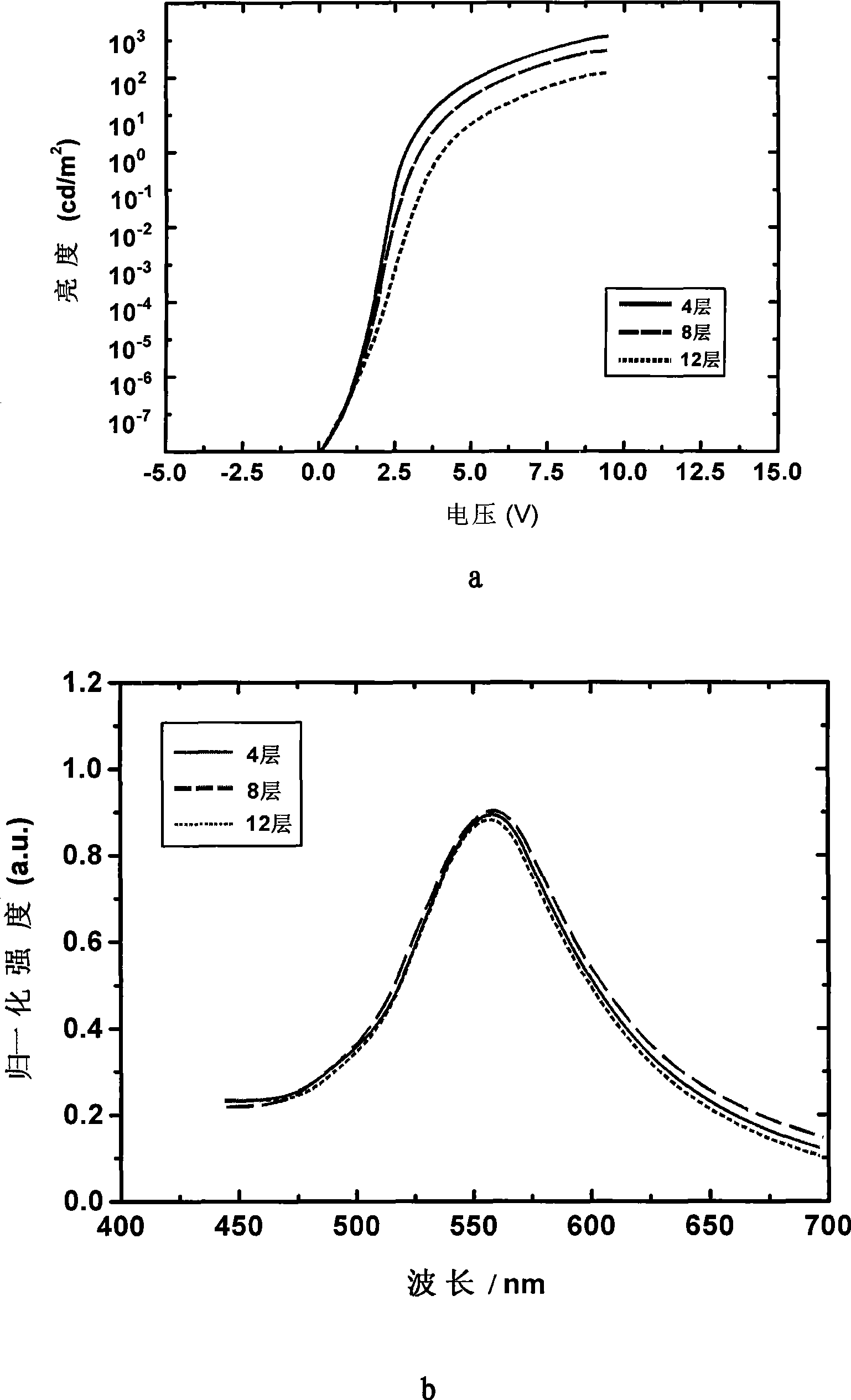Method for preparing organic electroluminescent device
An electroluminescent device and luminescent technology, which is applied in the direction of electric solid-state devices, semiconductor/solid-state device manufacturing, electrical components, etc., to achieve the effects of increasing injection efficiency, reducing contact barriers, and wide selection range
- Summary
- Abstract
- Description
- Claims
- Application Information
AI Technical Summary
Problems solved by technology
Method used
Image
Examples
Embodiment 1
[0067] like figure 1 As shown, the organic functional layer in the device structure includes a hole transport layer 2, a light-emitting layer 3 and an electron transport layer 4, wherein the light-emitting layer 3 is a blue light-emitting layer or a green light-emitting layer, respectively.
[0068] The hole transport layer material of the device is NPB, and the light emitting layer material is BAlq or Alq 3 , the electron transport material is Alq 3 , Mg:Ag alloy for cathode layer. The entire device structure is described as:
[0069] Glass substrate / ITO / {(3,4-polyethylenedioxythiophene / polystyrenesulfonic acid) / double octadecyl chain / (3,4-polyethylenedioxythiophene / polystyrenesulfonic acid) acid)} n (n=4, 8, 12) / NPB(20nm) / BAlq(10nm) / Alq 3 (10nm) / Mg:Ag(100nm)
[0070] The preparation method is as follows:
[0071] (1) Ultrasonic cleaning was performed on the anode substrate with detergent, ethanol solution and deionized water, and after cleaning, 25% ammonia water: 30%...
Embodiment 2
[0082] like figure 1 As shown, the organic functional layer in the device structure includes a hole transport layer 2, a light-emitting layer 3 and an electron transport layer 4, wherein the light-emitting layer 3 is a blue light-emitting layer or a green light-emitting layer, respectively.
[0083] The hole transport layer material of the device is NPB, and the light emitting layer material is BAlq or Alq 3 , the electron transport material is Alq 3 , Mg:Ag alloy for cathode layer. The entire device structure is described as:
[0084] Glass substrate / ITO / {(3,4-polyethylenedioxythiophene / polystyrenesulfonic acid) / double octadecylammonium bromide chain / (3,4-polyethylenedioxythiophene / polyethylenedioxythiophene) styrene sulfonic acid)} n (n=4, 8, 12) / NPB(20nm) / BAlq(10nm) / Alq 3 (10nm) / Mg:Ag(100nm)
[0085] The preparation process of the device is the same as that of Embodiment 1
Embodiment 3
[0087] like figure 1 As shown, the organic functional layer in the device structure includes a hole transport layer 2, a light-emitting layer 3 and an electron transport layer 4, wherein the light-emitting layer 3 is a blue light-emitting layer or a green light-emitting layer, respectively.
[0088] The hole transport layer material of the device is NPB, and the light emitting layer material is BAlq or Alq 3 , the electron transport material is Alq 3 , Mg:Ag alloy for cathode layer. The entire device structure is described as:
[0089] Glass substrate / ITO / {(polyaniline / polystyrenesulfonic acid) / double octadecyl chain / (polyaniline / polystyrenesulfonic acid)} n (n=4, 8, 12) / NPB(20nm) / BAlq(10nm) / Alq 3 (10nm) / Mg:Ag(100nm)
[0090] The preparation process of the device is the same as that of Embodiment 1
PUM
 Login to View More
Login to View More Abstract
Description
Claims
Application Information
 Login to View More
Login to View More - R&D
- Intellectual Property
- Life Sciences
- Materials
- Tech Scout
- Unparalleled Data Quality
- Higher Quality Content
- 60% Fewer Hallucinations
Browse by: Latest US Patents, China's latest patents, Technical Efficacy Thesaurus, Application Domain, Technology Topic, Popular Technical Reports.
© 2025 PatSnap. All rights reserved.Legal|Privacy policy|Modern Slavery Act Transparency Statement|Sitemap|About US| Contact US: help@patsnap.com


